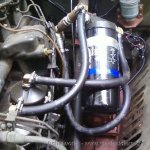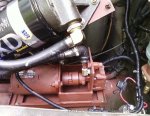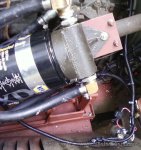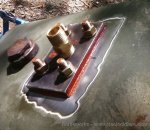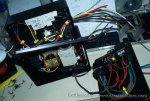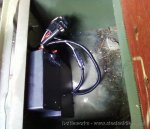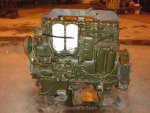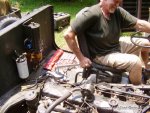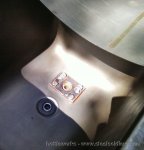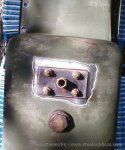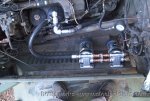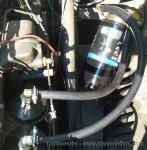bottleworks
New member
- 920
- 3
- 0
- Location
- Central NC
This is something that I have been gathering up parts for sometime. The stock oil system simply sucks for the type of situation it is in (it's not in the arctic). The stock system takes 12-15 sec until oil pressure is built up. The stock filters don't filter very well. A year ago I updated to dual Wix XD filters. Later, I changed to the OD Iron remote oil filter system. Both of those systems cut down the time-til-pressure significantly. However, most engine wear is caused at startup and most turbo damage is caused at shutdown. So, I set out to make a pre/post lube system. I looked at the systems available on the market. I didn't like them and they were too expensive. So I made my own.
The pump is made from an M151 starter and a Mopar 318 (only the best) oil pump. I machined a seal retailer to fit on the snout of the oil pump and used a standard Lov-Joy coupling to connect the two together. It is then plumbed together with the remote oil filter.
Next came the oil supply.
The systems that you can buy have you replace the oil pan plug with an adapter. I didn't like that, so I added a port at the bottom of the oil pan. It has a replaceable gasket that only take 4 nuts to get to. There is also a shutoff valve there if something were to go wrong.
Finally the controller.
I wanted a system that I could touch a button and it started. When I turn off the truck, it started automatically for a preset amount of time. So, I made one. It took 1 latching relay, three standard Bosch relays, a one shot timer, a 3PDT relay, a heavy current solenoid, three diodes, and a 5 PSI oil pressure switch. Oh, and two voltage regulators & two LEDs for fun. You press the red button to activate, it then kicks the pump on (and both the "System Ready" and "Pump Active" LEDs). Once it finishes the oil system is at pressure and the pre/post lube system stay "ready" until the oil pressure drops below 5 psi. Once pressure drops below 5 psi, the pump kicks back on. Once the pump turns off, the system is shutdown and draws 0 mA. The timer has a range between .05 secs - 4 Hrs. Right now, I have it set a 30 secs. The pump can maintain cold oil pressure of ~45PSI and worm pressure of ~25-30 PSI.
The pump is made from an M151 starter and a Mopar 318 (only the best) oil pump. I machined a seal retailer to fit on the snout of the oil pump and used a standard Lov-Joy coupling to connect the two together. It is then plumbed together with the remote oil filter.
Next came the oil supply.
The systems that you can buy have you replace the oil pan plug with an adapter. I didn't like that, so I added a port at the bottom of the oil pan. It has a replaceable gasket that only take 4 nuts to get to. There is also a shutoff valve there if something were to go wrong.
Finally the controller.
I wanted a system that I could touch a button and it started. When I turn off the truck, it started automatically for a preset amount of time. So, I made one. It took 1 latching relay, three standard Bosch relays, a one shot timer, a 3PDT relay, a heavy current solenoid, three diodes, and a 5 PSI oil pressure switch. Oh, and two voltage regulators & two LEDs for fun. You press the red button to activate, it then kicks the pump on (and both the "System Ready" and "Pump Active" LEDs). Once it finishes the oil system is at pressure and the pre/post lube system stay "ready" until the oil pressure drops below 5 psi. Once pressure drops below 5 psi, the pump kicks back on. Once the pump turns off, the system is shutdown and draws 0 mA. The timer has a range between .05 secs - 4 Hrs. Right now, I have it set a 30 secs. The pump can maintain cold oil pressure of ~45PSI and worm pressure of ~25-30 PSI.
Attachments
-
65.7 KB Views: 1,446
-
79.8 KB Views: 1,452
-
69.7 KB Views: 1,430
-
43.6 KB Views: 1,439
-
32.8 KB Views: 1,414
-
68.4 KB Views: 1,403



